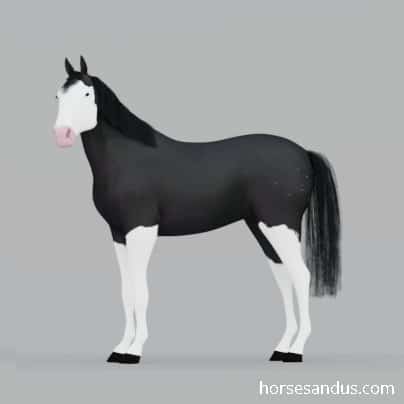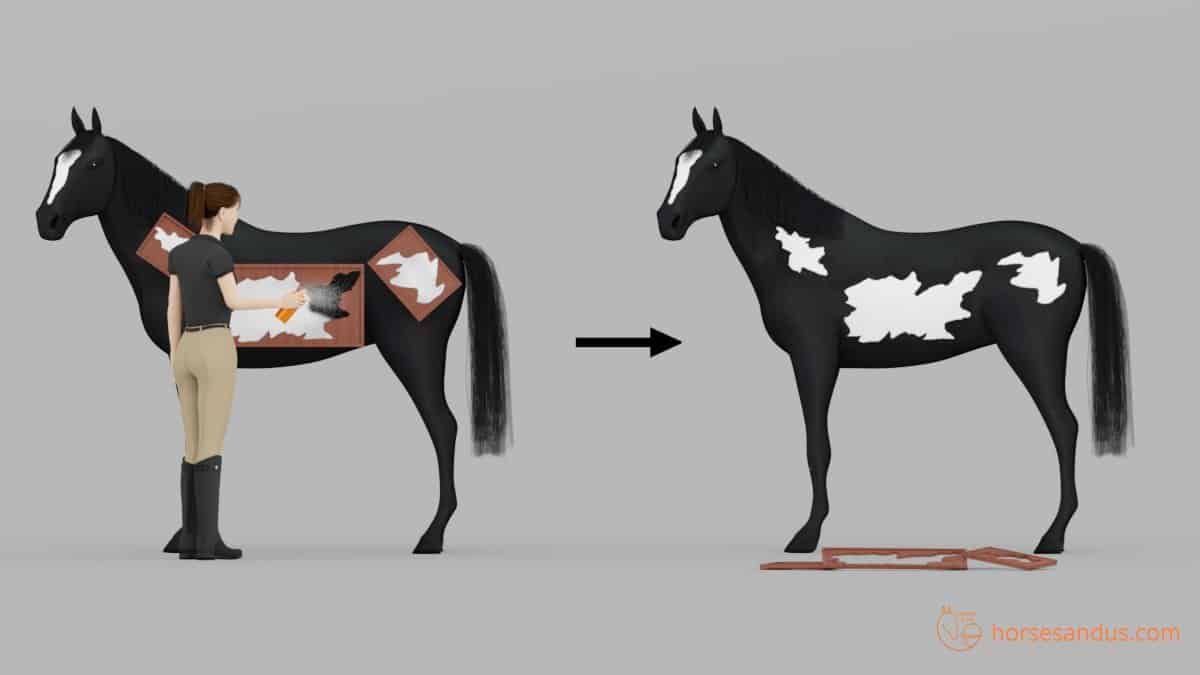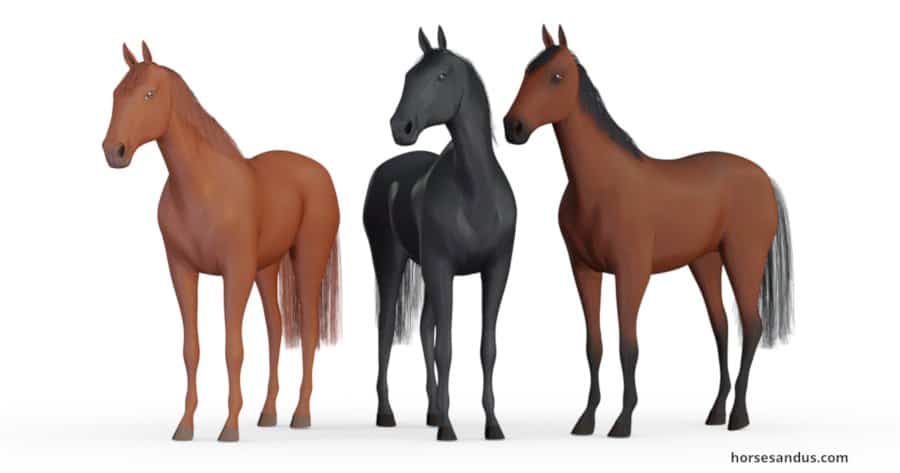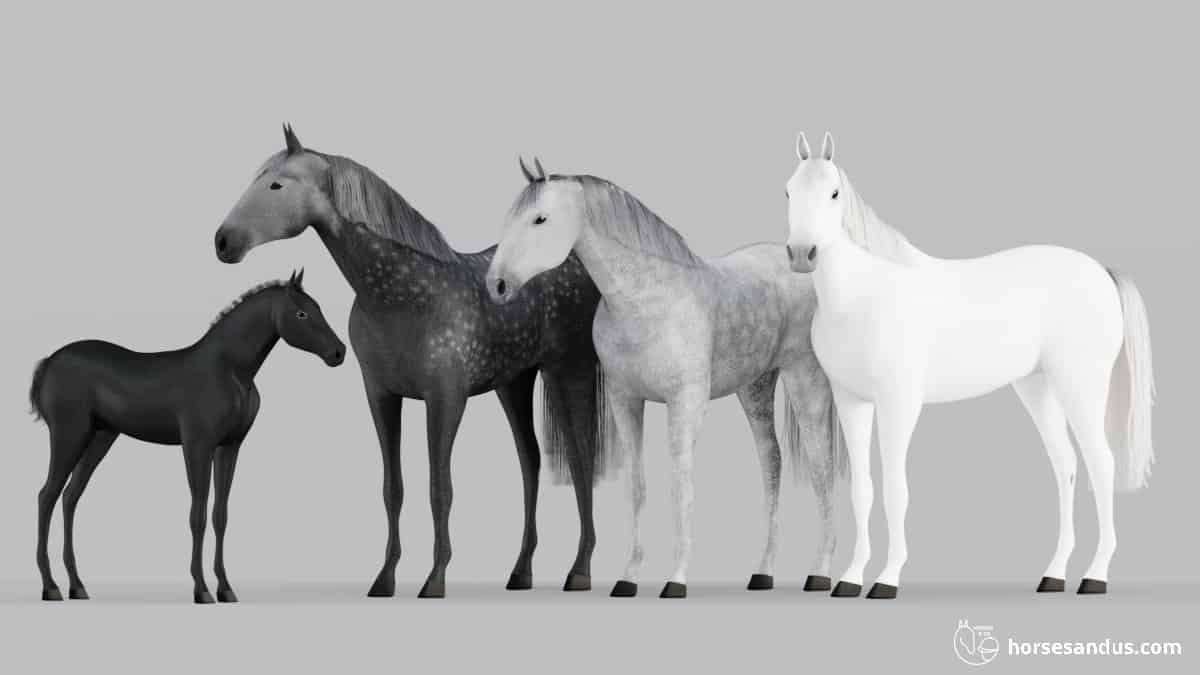White horses have a special meaning in mythology (Pegasus and Unicorn) and different cultures worldwide (representing wisdom, power, fertility, or even death). But what is a true white horse?
A Dominant white horse also called “white” or “spotted white,” has a white pattern produced by mutations of the KIT gene (W1,W2,…). It’s characterized by white spotting. However, the extent of white is highly variable, ranging from only white spots on the face and legs to completely white. The eyes are usually brown but can occasionally be blue.
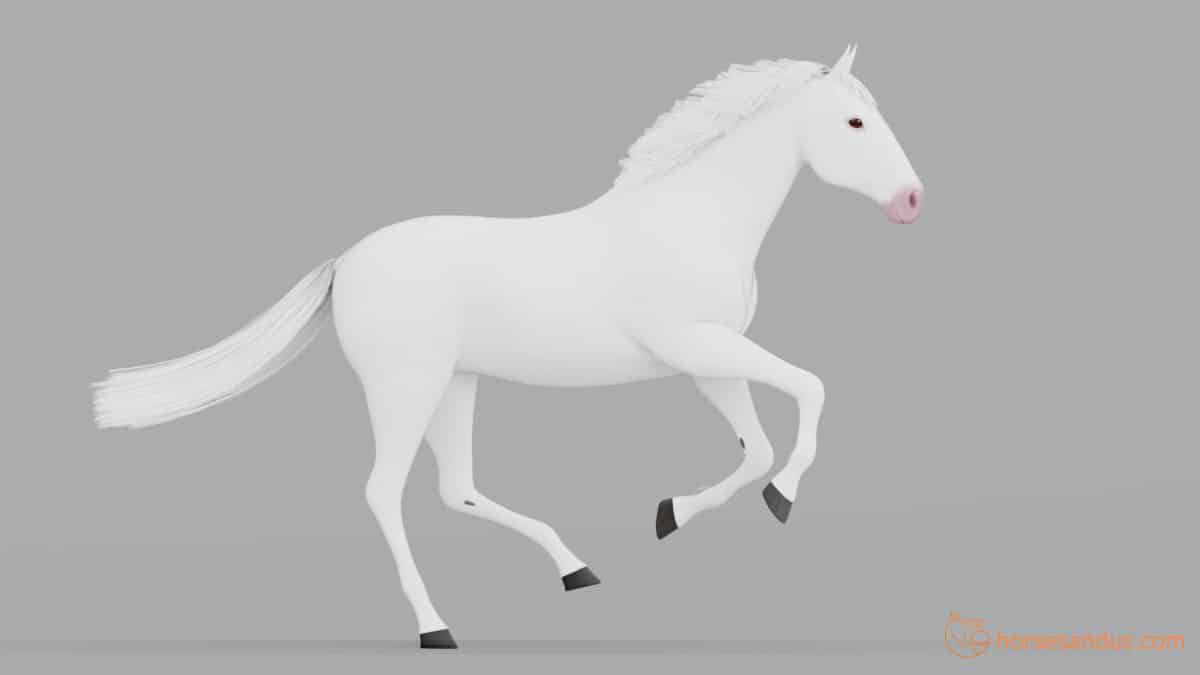
There are many different mutations of the kit gene for dominant white, W1, W2, W3,….
Until now 30 different alleles have been discovered (source).
There is a wide variety of horse coat colors and patterns. In this article, we will look at the patterns produced by the Dominant White gene.
Characteristics Of Dominant White Horses
- The Dominant White pattern displays white patches over 50% to 100% of the body. Typically they are nearly completely white. The more colored horses are rare. Dominant Whites can be easily confused with Sabinos.
- There are many Dominant White alleles, and each produces different traits.
- Some alleles produce brown eyes, while others produce blue eyes.
- Some alleles produce more extensive white than others.
- W20 appears to produce a completely white horse when combined with other dominant white alleles and also with other white pattern genes.
The Dominant White pattern can occur with any base coat color (black, chestnut, bay) or diluted coat color (dun, cream, silver, or champagne).
It can also exist in conjunction with other white patterns (Frame, Sabino, Tobiano, Splashed White, Leopard Complex, or Roan).
Variability Of The Dominant White Pattern
The term dominant white is misleading because it leads to the belief that these mutations will produce completely white horses. However, this is not always the case.
Dominant white (W) patterns can vary greatly in the extension of white on the coat. They can range from a completely white coat to only white markings on the face and legs.
We can group dominant white horses into three different categories:
This grouping is just to give an idea of the range of white area that can exist for different Dominant white expressions, but the borders between categories can be quite fuzzy.
Additionally, the variability increases enormously when the 2 alleles (one from each parent) have different combinations. Let’s consider, for example, the W20 allele.
- When only this allele is present (w/W20), the coat will be colored with a white face and leg markings.
- When combined with other dominant white alleles (W5/W20, W10/W20, or W22/W20 ), the coat will be typically all white.
The eye color is commonly brown.
The Genes Behind Dominant White

The letter W has been used for a long time to represent Dominant White in horses. We will use w (little w) to represent the recessive allele. All non-white horses are ww.
As the name suggests, the Dominant White allele is a dominant allele, which means that only one copy of the allele is needed to express the Dominant White traits. Both homozygous (W/W) and heterozygous (W/w) horses exhibit the same phenotype.
The Dominant White mutations are located on the KIT gene.
The KIT gene in horses is responsible for many different white patterns. These white patterns can be grouped into four different allele types: sabino(SB1), tobiano(TO), roan(RN), and dominant white(W)
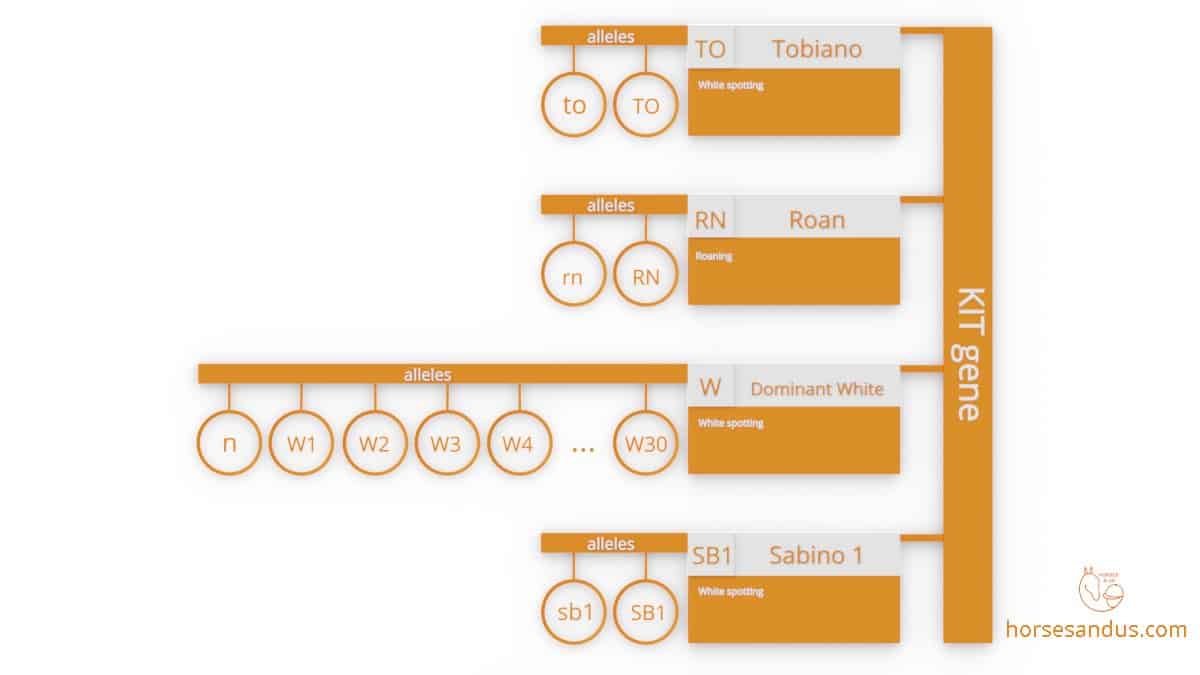
Discovering the Dominant white alleles
Sabino 1 was identified in 2005. The researchers named this allele Sabino 1 because they thought they would find more alleles and would then name them Sabino2, Sabino3, etc.
However, the next allele that was found on the KIT gene caused a dominant white trait. So the allele was named W1. The following alleles found on the KIT gene also produced the dominant white trait, and so they were named W2, W3, … and so on.
After that, the following alleles discovered on the KIT gene were given a name on the W series, even those with sabino-like patterns. Perhaps some of these alleles should have been named sabino instead of white.
So most probably, the Sabino 2 will never be named, and if more sabino-like alleles are found, they will likely be designated within the W series.
In any case, all these alleles are versions of the same KIT gene.
Dominant White genes inheritance
Because all the alleles, W1, W2, W3,….., SB1, TO, and RN are on the same gene (KIT), only two of them can be present in a horse (one from the sire and another from the dam).
So, for example, we can have genotypes with only dominant white alleles like W20/W20 or W20/W22 or genotypes that cross different white patterns on the KIT gene, like, for example, W20/TO, W20/SB1, or W20/RN.
This also means that if a horse has two KIT gene patterns (ex: W20/TO), it will pass one or the other to its offspring but never both.
Combination of Dominant White With Other White Patterns
Horses can carry two KIT gene mutations, ex: W1/TO, and an additional splashed white (SW) plus a Frame Overo (O) because different genes create these different white patterns.
These successive additions, acting together in a cumulative way, can create coat colors that make it impossible to visually detect the genes behind it. In these cases, it is necessary to perform a DNA test.

Breeds Where We Can Find The Dominant White Pattern
Dominant white has appeared, although rarely, among some breeds of horses.
The table below shows which alleles have been found in the different breeds.
Considering the high diversity of mutations that have been found so far in the KIT gene, it is likely that new alleles of the W series can appear in any breed of horse.
| Allele | Breed | Phenotype |
|---|---|---|
| W1 | Franches-Montagnes. Horses trace back to Cigale, a mare born in 1957. | Completely white |
| W2 | Thoroughbred. Horses trace back to KY Colonel, a chestnut with extensive markings born in 1946 | Completely white |
| W3 | Arabian. Horses trace back to R Khasper, near white stallion born in 1996 | Mostly white. Horses homozygous W3/W3 are likely embryonic lethal |
| W4 | Camarillo White Horse. The Camarillo White Horse is a rare horse breed less than 100 years old known for its pure white color. It started in 1912 with the stallion named Sultan. | Completely white or mostly white with colored markings that fade with time |
| W5 | Thoroughbred. Horses trace back to Puchilingui, a stallion born in 1984. | The phenotype varies from Sabino-like pattern to completely white Horses homozygous W5/W5 are likely embryonic lethal, but this still needs to be confirmed. |
| W6 | Thoroughbred. Only identified in a single white horse born in 2004 | Mostly white, flecked all over |
| W7 | Thoroughbred. Identified in a partially white filly | Mostly white |
| W8 | Icelandic Horse. Identified in a partially white horse. | Mostly white sabino-like pattern |
| W9 | Holsteiner. Identified in a completely white horse born in 2006 | Completely white |
| W10 | Quarter horse. Horses trace back to GQ Santana born in 2000 | The phenotype varies from Sabino-like pattern to completely white |
| W11 | German Draft. Identified in a complete white stallion born in 1997 and three white offspring | Completely white |
| W12 | Thoroughbred. Identified in a single colt born and died in 2010 | Half white |
| W13 | Quarter horse and Peruvian Paso. Identified in a crossbred family with two white animals. Founder is unknown | Completely white |
| W14 | Thoroughbred. The founder is suspected to be Shirayukihime, born in 1996. | Completely white |
| W15 | Arabian. The founder is Khartoon Klassic born in 1996 | Heterozygous partially white, and homozygous are completely white. |
| W16 | Oldenburg. Identified in a family with three almost complete white horses. the founder is suspected to be Celene born in 2003 | Mostly white |
| W17 | Japanese draft. Identified in a horse born in 2010 | Completely white with one blue eye and one brown eye |
| W18 | Swiss Warmblood. Identified in a single white horse with extended white speckled areas. | Sabino-like pattern |
| W19 | Part-Bred Arabian: The founder is suspected to be Fantasia Vu, born in 1990 | Bald faces extended white legs and irregular belly spots |
| W20 | Many breeds | Very common mutation. Is thought to be a white booster. W20 on its own causes markings on the face and legs, and small belly spots. When combined with other mutations from KIT gene, W20 greatly increases the white area. |
| W21 | Icelandic Horse. Identified in a single horse with a sabino-like pattern. | Sabino-like with blue eyes. |
| W22 | Many breeds Thought to have originated in Thoroughbred mare called Not Quite White, born in 1989. | Sabino-like to completely white. W22 is sabino-like, but when combined with W20, is completely white |
| W23 | Arabian Founder born in 1989. but line appears to have died out | Mostly white |
| W24 | Italian Trotter Via Lattea, born in 2014 | |
| W25 | Australian Thoroughbred. Originated in a mare called Laughyoumay, born in 2001 | Partial to completely white |
| W26 | Australian Thoroughbred Originated in a mare called Marbrowell, born in 1997 | Partial to completely white |
| W27 | Australian Thoroughbred Originated in a mare called Milady Fair, born in 1960. Most horses with this mutation are descended from her great-grand-colt, Colorful Gambler. | Partial to completely white. |
| W28 | German Riding Pony | |
| W30 | Berber. Identified on Aghilasse and his son Kairaan | Mostly white |
Health Issues Associated With Dominant White
Problems associated with pink skin
As with any depigmented horse, dominant white horses will be extra sensitive to sun exposure, due to the lack of protective pigment.
The pink skin of white horses does not have melanin and therefore is not protected when it is exposed to sunlight. This leaves the skin at the mercy of UV rays and vulnerable to damage.
This is not simply a sunburn, it may cause skin lesions. These lesions present redness, swelling, and itching. Subsequent infections may occur, followed by necrosis and shedding of skin. Cancer of the skin may also develop.
You may want to try the Summer Care Butter to protect your horse´s skin from sunburn. This product can be purchased at Amazon.
Famous White Horses
Most famous white horses are actually greys with hair coats turned to fully white.
Examples are:
- Marengo, the famous war horse of Napolean, was a grey Arabian.
- Shadowfax, the horse, ridden by Gandalf in the “Lord of the rings” was portrayed by two grey horses of the Andalusian breed.
- Desert Orchid (Dessie) racehorse was a Thoroughbred grey horse.
However, the horse “Silver”, ridden by the Lone Ranger, was a true white horse.
Another famous truly white horse is Yukichan, a Japanese Thoroughbred racehorse.
Dominant White Horses Compared to Grey And Cream Horses
Grey horses and cream horses (Cremello and Perlino) are often called white because the hair appears to be white, but these are not true white horses. The true white horses are produced by White Pattern genes.
In this comparison, we are considering dominant white horses that have completely white coats.
Dominant White Horses versus Grey Horses
Grey Horses are often confused with true white horses, however, it is quite easy to differentiate them.
- Skin color- Unlike the grey horse’s dark skin, the white areas of the Dominant white horse have pink skin underneath. The color of the underlying skin is usually only visible in areas with little hair, such as the muzzle and around the eyes.
- Change in coat color– A dominant white horse appears white at birth, while a grey horse is born with a colored coat that progressively whitens as it grows older.
Dominant White Horses versus Cream Horses
A double dilute cream horse such as Perlino and Cremello will appear white, but there are some subtle differences when compared to a true white horse.
- Eye color – The Dominant white horse will typically have brown eyes, while the cream horse will usually have blue eyes.
- Hair color – Although a cream horse’s hair looks white, you can see the subtle difference if you place a cream horse next to a Dominant white horse.
- The Cream horse will have a slight cream tone to its coat due to the cream gene’s double dilution.
- The Dominant White will have a true white coat, resulting from complete depigmentation produced by the Kit gene.
Further Reading
If you would like to learn more about horse colors and white patterns, you may want to read the following books, available on amazon.
The links below that lead to products on Amazon are affiliate links and I earn a commission (with no additional cost for you) if you make a purchase.
The following books are an introduction to horse colors and white patterns which are full of images and very easy to understand.
The Equine Tapestry: An Introduction to Colors and Patterns The Ultimate Guide to Horse ColorsA more technical book about horse colors, but still very easy to understand.
Equine Color GeneticsSources
https://apha.com/wp-content/uploads/2016/09/TheColorInside1.pdf
https://practicalhorsegenetics.com.au/index.php?test=mic
https://www.etalondx.com/dominant-white
Equine Color Genetics 4th Edition by D- Philip Sponenberg
